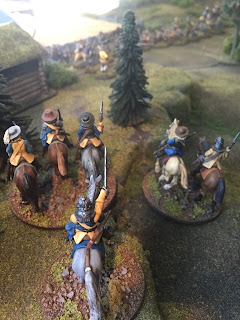Introduction
After a long summer and a quiet blog its time for an AAR from a while back.
We played a Thirty Years War game using the excellent Pikeman's Lament rules of Dan Mersey and Michael Leck.
During the Thirty Years War many Scotsmen served with the Swedish army. The war had been raging on the European continent for already more than a decade when Gustavus Adolphus in 1630 landed in Northern Germany with an army, initially to take control over the German cities on the northern German coastline. Reay's Regiment, a regiment under Scottish commander Donald Mackay, 1st Lord of Reay, joined the Swedish forces and was involved in taking the coastal cities of Stettin and Colberg.
Our game is set in between the taking of those two cities. During that time, in August 1630, six companies of Reay’s Regiment, was ordered to re-join the main body of the regiment at Stettin. En route, one of the boats foundered off the Pomeranian coast near Colberg, and nearly 200 men landed with only themselves, their ‘swords, pikes and some wet muskets’. The Scots surprised the town of Rügenwald and obtained fresh powder and ammunition. They held the town for nine weeks until Gustavus Adolphus sent Hepburn’s Scottish regiment to relieve them (for more information have a look here).
In our scenario an Imperial probing force is closing on Rügenwald and some men of the Reay's Regiment mount up to meet them. For this we used the Gå På-scenario from the Pikeman's Lament, a straightforward fight between two companies, with scores for routing or wiping out enemy groups.
The Opposing Forces
Scottish
6 Gallopers including Officer @ 4 pts
6 Gallopers @ 4 pts
6 Gallopers @ 4 pts
6 Gallopers @ 4 pts
12 Shot @ 4 pts
12 Shot @ 4 pts
12 Pike @ 4 pts
 |
| The Scotsmen from Reay's Regiment |
Imperial
6 Trotters including Officer @ 4 pts
6 Trotters @ 4 pts
12 Shots @ 4 pts
12 Shots @ 4 pts
12 Shots @ 4 pts
12 Pike @ 4 pts
6 Dragoons @ 4 pts
 |
| The Imperial Attackers |
The Game
The game begun with both sides advancing. It soon became clear that the Imperial side could find good defensive positions on their side, covering the open ground in the middle of the battlefield. Also, the Scottish infantry in the center had difficulties keeping up with its cavalry. It didn't help that the Scotsmen got a message from their commander back in Rügenwald calling a group of men from the field of battle (a Random Event: rolling a doubble '1' for Activation followed by a '6')! However, the same group of men came back just a turn later (rolling a dobble '6' for activation followed by a '6')! We laughed as the Scottish commander obviously couldn't make up his mind.
The Scottish cavalry heavy forces failed to get to grips with the Imperial forces and where instead steadily depleeted through Imperial musket fire. A group of Scottish Gallopers tried to turn the Imperial flank but failed to make true impact. When the Imperials, through yet another Random Event, got reinforcements on that very flank the fight was all but over.
Some poor Scottish cavalry deployment facing well placed Imperial infantry gave a hesitant Scottish advance and manouvering in the face of Imperial musketry. The end result being that the Scots of the Reay's Regiment had to retreat to Rügenwald, and wait for Gustav Adolphus to send troops to save the day.
 |
| The Scottish cavalry advances... |
 |
| ...as the infantry try to keep up in the field. |
 |
| The Imperial line, with Trotters coming down the hill. |
 |
| A close order group of Imperial pike - reinforced with Shot in good positions - making the Scottish cavalry hesitate. |
 |
| With an overcrowded left flank met with fierce resistance some of the Scottish cavalry try to find another way forward... |
 |
| ...but the Imperials pour fire into the Scottsmen trying to manouver in the field. |
 |
| The Imperial line, well positioned. |
 |
| A group of Swedish cavalry - having entered the field of battle through the hamlet - arrive to try to turn the Imperial flank |
 |
| "Our commander needs us elsewhere! Lets go!" The Scottish pike are called off the field of battle. Only to return a turn later. :-) |
 |
| Swedish cavalry on the extreme left flank. |
 |
| The Scottish cavalry finaly attacks... |
 |
| ...crushing into Imperial Shot. |
 |
| A swirling cavarly clash in the center. |
 |
| Having beaten back the Imperial Trotters at a very high cost, the lone surviving horseman of the flanking Swedish Gallopers is in turn attacked by Imperial reinforcements. Game over. |











































